With M14 fully spoiled, it becomes our job (well, certainly mine, but I suspect most of you will be thinking about it as well) to predict what impact these new cards will have on the established Standard metagame. It takes time for people to learn how to use most new cards, and at the very beginning Standard will largely resemble the current format with some new ideas mixed in. There will be a few decks built around new cards, but for the most part they’ll be operating at a bit of a disadvantage because people will be essentially playing with first drafts. This means that the most important thing is to understand how the new cards impact the balance of power among existing decks.
At the moment, there’s a strong balance of power, by which I mean that there are a huge number of roughly similarly successful decks. This makes it hard for new hate cards to really shake things up, because no one knows what to target. However, most of the new hate cards are broad enough that they attack an extremely wide variety of decks, which is what we need.
Take Lifebane Zombie, for example. Take a minute to think about how many decks in the format have no green or white creatures. If you count Burning-Tree Emissary and Boros Reckoner (and why wouldn’t you?), even mono-red has targets. Esper Control? Restoration Angel, Obzedat, Ghost Council, Blood Baron of Vizkopa. Grixis is the least popular color combination at the moment, and since a vast majority of decks are three colors, almost everyone has something you can take. Obviously Lifebane Zombie isn’t likely to hit against a deck with only 4-8 targets, but given that the body itself is respectable it’s not the worst thing ever to have it in the maindeck against those people. I suspect the only decks that won’t have green or white creatures will be those new decks build to take advantage of Lifebane Zombie, but even most of them will have green or white creatures of their own.
While Lifebane Zombie attacks most of the format, it does not punish everyone equally. It is at its absolute best against Junk Reanimator, since they have a large number of green and white creatures that cost 5+ mana that will always be in their hand, plus exiling creatures is exactly what you want to do against them to stop them from being able to use Unburial Rites. Often, people will lose to Junk Reanimator after successfully hating the graveyard because that takes enough time for the opponent just gets to seven mana and cast Angel of Serenity, which will win the game. With Lifebane Zombie, after you’ve hated the graveyard you can strip their hand, then they’ll need to topdeck their answer.
Lifebane Zombie is similarly good against anyone who’s leaning heavily on Thragtusk to bridge the gap to a late game. The best part is that the 3/1 Intimidate body can keep attacking through any other big defensive green or white creatures (well, not Obzedat, Ghost Council or Blood Baron of Vizkopa) that they play later.
Lifebane Zombie is my early pick for most influential card in M14, but it needs to find a home where people can cast it. I don’t think that’s too hard. I’d start by looking at every deck that currently plays Sin Collector to see if the mana can support double black. Sin Collector is usually a sideboard card, and many of those decks will still want it there, but this will likely join it in the sideboard and come in in slightly different places. The body is substantially better once it’s in play.
It’s unclear to me whether this will or whether it should lead to a new Zombie deck emerging. I haven’t loved Gravecrawler in this format, and it’s been hard for Zombie decks to beat Burning-Tree Emissary decks, but maybe Gnawing Zombie can help with that. I’d love this card if it had a cheaper activation cost, and it probably isn’t good enough as is, but Zombies have always been looking for a better two-mana zombie. I think Gloom Surgeon is likely the best option, but it’s possible that this is the next-best, depending on your colors and how you feel about Blood Artist.
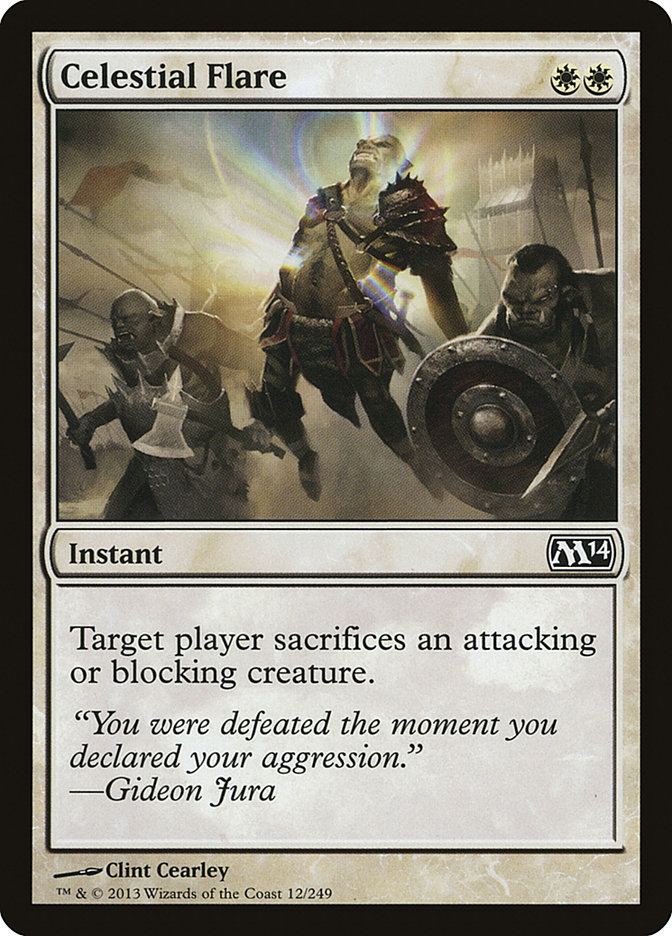
Celestial Flare is an interesting option. White gets another Edict to supplement Renounce the Guilds, and this gives UWR Flash a good answer to early Invisible Stalkers in addition to Geist of Saint Traft. Double-white is a little steep, but certainly within that deck’s range since they were looking to be able to Supreme Verdict anyway. This card definitely looks playable to me, and I think it could relevantly hurt the position of Bant Hexproof decks, though it’s worth noting that it does have a bit of a Voice of Resurgence problem, since you can’t just play it as a sorcery (I’m assuming the “sacrifice a blocking creature” mode won’t come up as often).
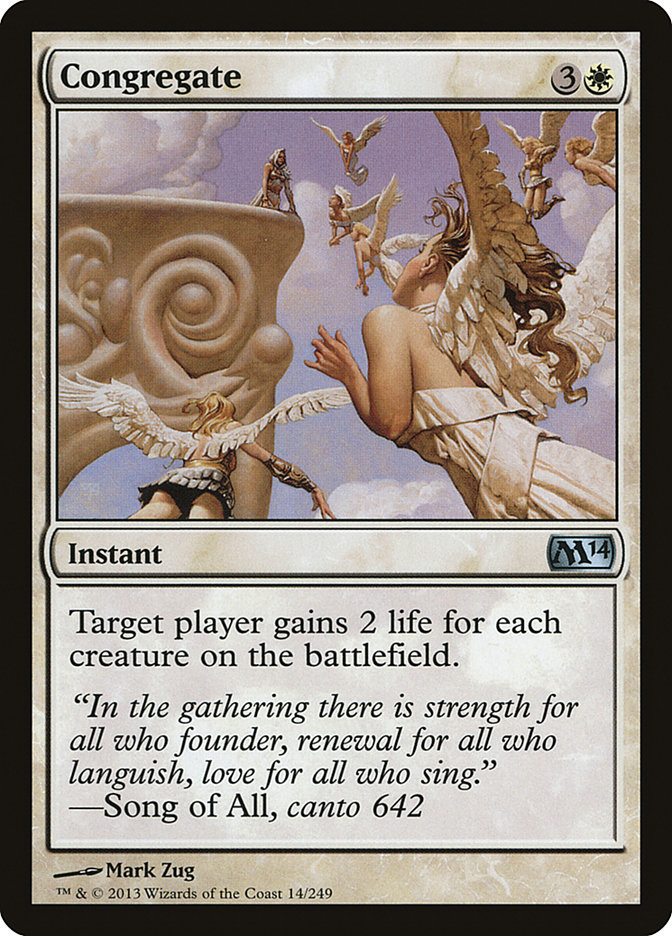
Congregate is a casual staple because it gains absurd amounts of life in most multiplayer games, but it’s also potentially a realistic sideboard option in Standard. It’s not uncommon to see games where this would gain 20+ life. I’m not sure how significant that is, but it’s a good thing to be aware of.
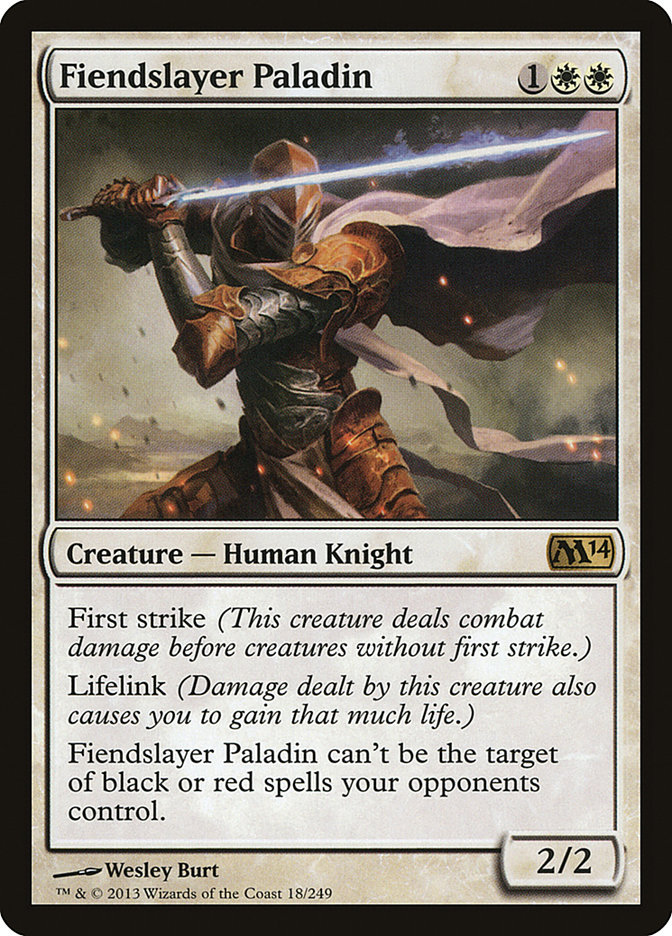
Fiendslayer Paladin feels a little slow to matter to me, but a creature that’s hard to kill and naturally has lifelink is definitely an appealing creature to enchant. It’s particularly good with Rancor or Madcap Skills, and very reasonable on its own against Burning-Tree Emissary. If Bant Hexproof’s primary concern becomes racing other aggressive decks, this becomes a real consideration.
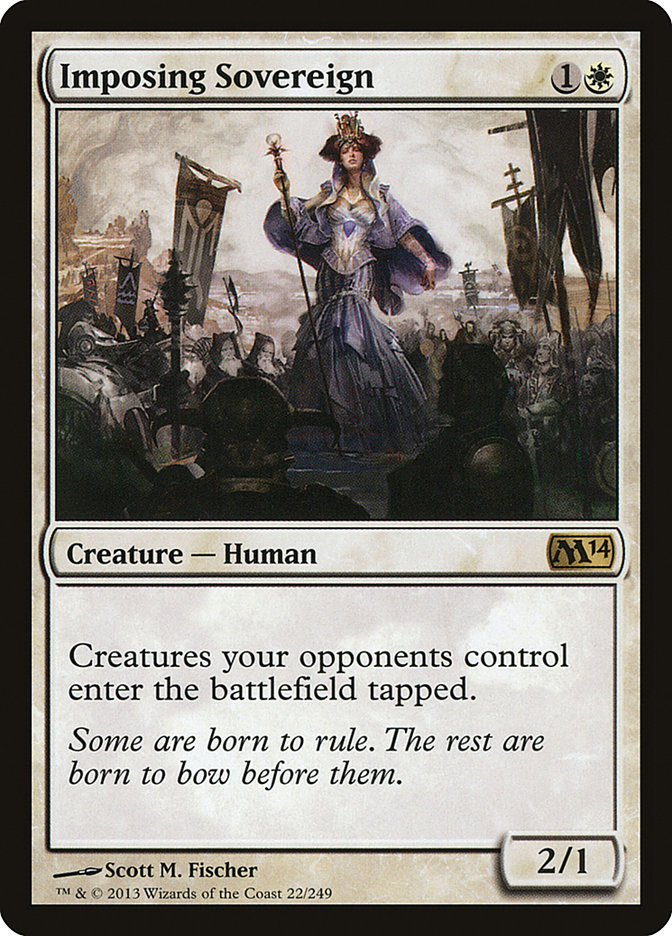
Imposing Sovereign is another awesome aggressive card that makes trying to block with Thragtusk a much less appealing option. If you follow a Champion of the Parish up with this, and your opponent doesn’t already have a creature in play, both are guaranteed not to be blocked on the next turn. When you’re trying to slow down haste creatures, this is probably worse than Blind Obedience, but when you’re the beatdown this card is incredible. Have you ever tried playing defense with Geralf’s Messenger? It’s generally even worse than you expect it to be until you’ve tried it. This card makes your opponents entire deck like that, and means you never have to worry about getting ambushed by Restoration Angel. This card is much better than it looks for aggressive Human decks, which didn’t really need this much help.
I wouldn’t be surprised if Imposing Sovereign saw more play than Lifebane Zombie.
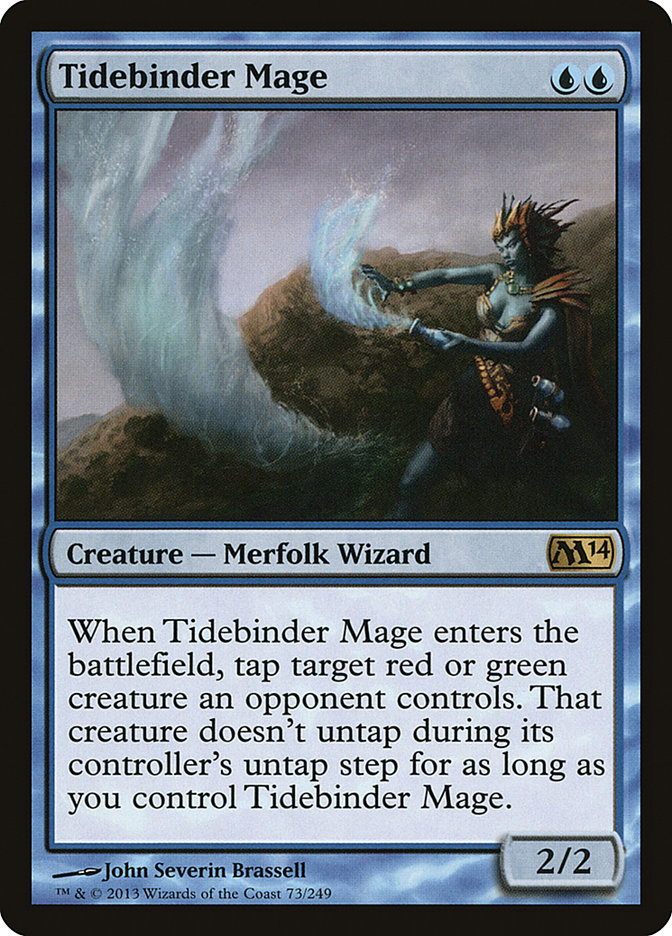
Tidebinder Mage is in a similar position to Lifebane Zombie, except it is best against aggressive decks while Lifebane Zombie is best against midrange decks. As with Lifebane Zombie, it’s important not to get too caught up in thinking of it as a tribal card. This is a great tempo play against any aggressive red or green deck, and where Lifebane Zombie pushes people to attack more rather than trying to lean on Thragtusk to beat attackers, this punishes them for trying to attack while also being an excellent aggressive creature that makes blocking difficult as well.
Like Lifebane Zombie, it doesn’t have an especially-obvious home. Competing with Snapcaster Mage and Augur of Bolas is difficult, and both of those creatures want you to keep the other creatures to a minimum. That might mean that we have to wait until after they rotate to really see Tidebinder Mage come into its own.
Also, I like the idea of Tidebinder Mage and Celestial Flare in the same deck, but that mana definitely scares me a little.
I’m noticing a trend, in that this set looks like it was designed very strongly to hate Thragtusk. (It’s funny how this always plays out, that sets give us the tools we’ve wanted for the last year just as the problems they’re answering are about to rotate.) All of this is sending a pretty clear message to me that I shouldn’t try to block with green creatures. Attacking is a little harder too. So far, all of this feels like a win for Supreme Verdict and Sphinx’s Revelation.
Corrupt is a card that bounces in and out of Standard, and every time it comes back, there’s a brief wonder if mono-black control is good enough. Mutilate is still in the format, which helps a lot, and it would be a good home for Lifebane Zombie. The new legend rule makes Liliana of the Veil much better, and allows her to be played in the same deck as Liliana of the Dark Realms, which is a card Corrupt really wants to play with. Shrivel is a useful sideboard tool for this kind of deck, as I’ve actually played Nausea in constructed before, and we even get Doom Blade back, which both helps our removal suite and rewards us for being mono-black as opposing Doom Blades will be dead against us. It’s not likely to be good enough, but it’s at least good enough to consider.
This is a rough sketch. It’s interesting that in game one there’s nothing you can really do on turn one, but after sideboarding you can fix that against most people. There’s a good chance this wants to splash a color for something, but it might not have to. Fortunately, there aren’t too many artifacts or enchantments you really need to be able to answer right now, though Witchbane Orb certainly isn’t a card this deck wants to see.
Also, Festering Newt is an unlikely possibility that could be better than Tragic Slip.
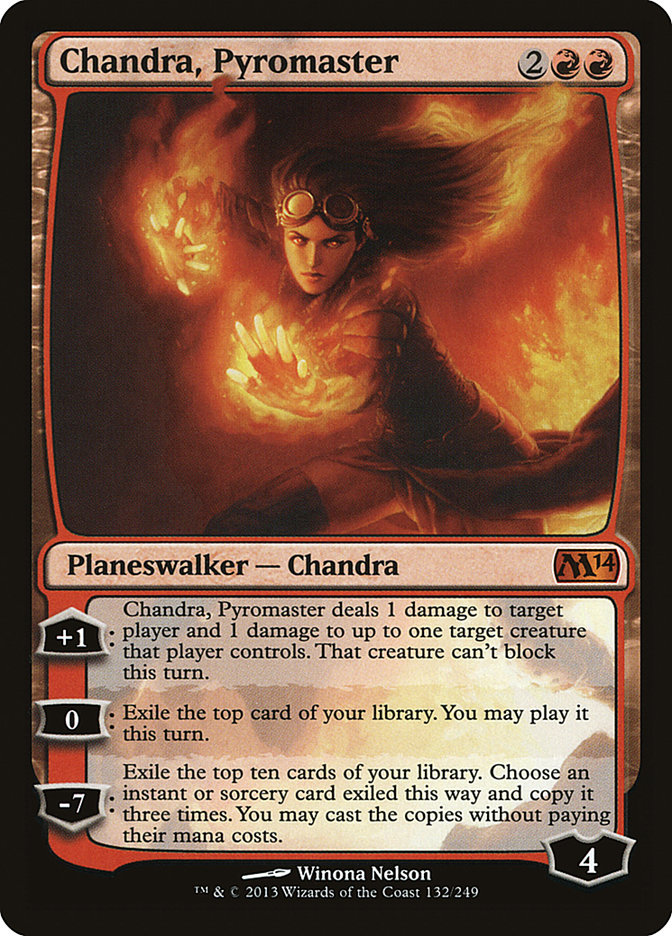
I think the new Chandra is fine but not great. The most likely red cards to matter are Burning Earth and Young Pyromancer. I don’t think there are enough cantrips for Young Pyromancer and Snapcaster Mage to be a thing in Standard, but there’s always a chance. I would love Young Pyromancer / Snapcaster Mage / Goblin Electromancer / Think Twice / Desperate Ravings to be a deck, but I doubt it is. The instants just take too long to cycle through given the speed of the format.
When I mentioned above that I wanted to play Supreme Verdict and Sphinx’s Revelation because of all these anti-creature cards, well, the Burning Earth people would definitely punish me for that decision. (More incentive for mono-black!) It’s hard to say if this is better or worse than Manabarbs. On the one hand, just having one or two basic lands in play goes a really long way to fighting Burning Earth. On the other hand, red-based decks that play this never have to worry about getting locked out by it, which would happen on occasion. It will be interesting to see how good this ends up being against decks like Jund Midrange. I could see red decks siding into this and removal and trying to essentially lock opponents out of the game, which is a very different role than Manabarbs played. It will be interesting to see how long it takes people to appreciate the strategic difference here in how it can be used differently, without actually needing to.
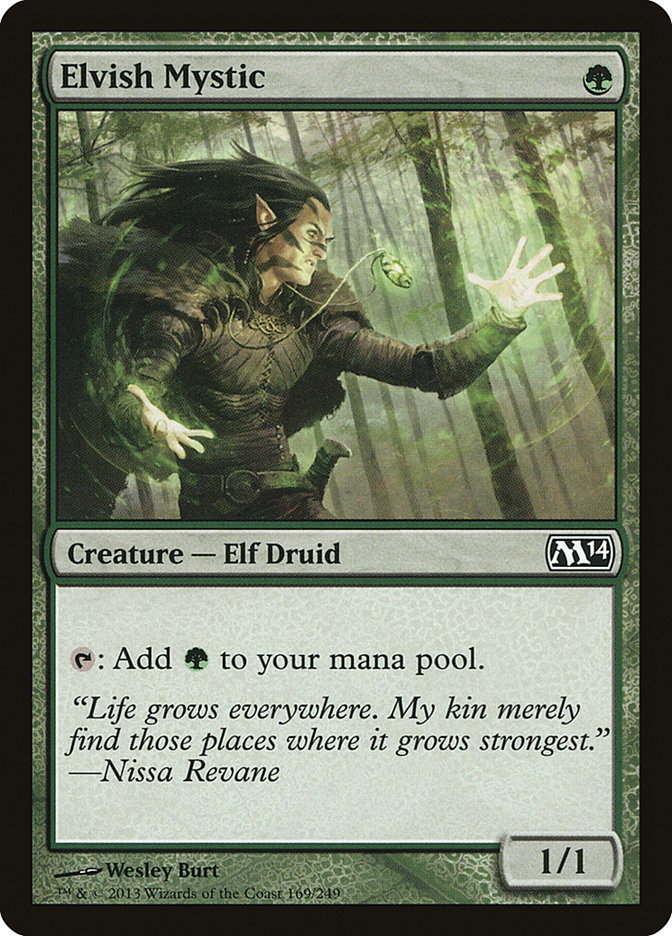
Elvish Mystic is another card that’s a Big Deal. It won’t really change existing decks much, but it’s a really important tool for green to have to build around. I think the most important spells for Elvish Mystic to cast are Elvish Archdruid, Garruk, Caller of Beasts, Craterhoof Behemoth (possibly all in the same deck), or Predator Ooze (likely a different deck). I’m cautiously optimistic about the elf deck. It looks powerful. I think it might go over the top of existing midrange decks pretty well. I’m not sure how good its backup plan can be against Rolling Temblor and Supreme Verdict. Maybe this is where Predator Ooze comes in, in sideboards, but then there’s Celestial Flare…
Scavenging Ooze is an important question to figure out. We need to work out where the best home for it is and how many we want. My guess is Jund. Jund can get opposing creatures into the graveyard early and then play it as a large blocker that gains life against aggressive decks, and it helps trump Junk Reanimator. This could just directly replace the four Ground Seals (two main, two sideboard) in Reid Duke winning deck from Grand Prix: Miami.
I’ve written about Kalonian Hydra in the past, but I think there’s a chance that it will turn out to be particularly well-positioned.
So with that substantial preface out of the way, let’s try to figure out what all these cards actually do to the landscape of Standard.
First of all, I think Scavenging Ooze and Lifebane Zombie (and to a lesser extent, Imposing Sovereign) are exactly the right kind of hate to make things substantially harder for Junk Reanimator. As we’ve seen in the past, adding a few hate cards to existing decks isn’t enough to trump that strategy, but these line up particularly well because they’re more flexible cards -they don’t just hate one plan like Rest in Peace, they affect the board in a relevant way and incidentally do things that line up well against Reanimator’s plan. I’m not declaring Junk Reanimator dead or anything, but I know that I personally would be scared to play it right after M14 comes out.
I think Imposing Sovereign and Elvish Mystic both strongly incentivize strategies that are extremely weak to Rolling Temblor or Bonfire of the Damned. Brian Kibler wrote about how people should be playing those before Grand Prix: Miami, and I think that will only become more true.
Burning Earth punishes multi-color control decks in a real and relevant way.
I’m not the sort to start here, but I think this is all painting a reasonably clear picture for me:
I think big, aggressive red/green decks (Kibler style) are going to be very well positioned after M14 comes out. One could splash a third color, but I think it’s best not to, because I think it’s important to make Burning Earth good and not good against you.
Creatures (24)
- 4 Arbor Elf
- 2 Scavenging Ooze
- 4 Huntmaster of the Fells
- 2 Wolfir Silverheart
- 4 Thundermaw Hellkite
- 4 Flinthoof Boar
- 4 Elvish Mystic
Planeswalkers (2)
Lands (24)
Spells (10)

Kalonian Hydra is tempting, since I just want to have the biggest guys in the mirror, but I think Wolfir Silverheart is better due to being somewhat hasty even against Imposing Sovereign.
I wonder again if mono-black is where I’d want to be against something like that…
Overall, I’m excited. I think M14 is giving us a lot of really interesting tools to shake things up.
Sam
@samuelhblack on twitter
